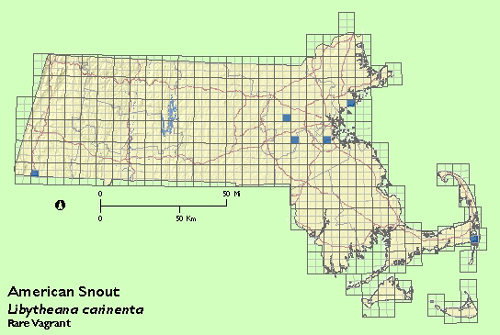Butterfly Atlas
Find a Butterfly
American Snout
Libytheana carinenta
Named
J. Abbot, 1800

Taxonomy & Nomenclature
Formerly Eastern Snout Butterfly (L. bachmanii); the present subspecies is now L.c. bachmanii.
Identification
Wingspan: 1 5/8 -2". The extended labial palps, creating a snout-like projection on the head, make this species unmistakable. While the orange, black, and white wing coloration are somewhat reminiscent of the Vanessa species, note the squared off forewing tips.
Distribution
Ranges from southern Arizona east to Virginia south through Mexico to Argentina with periodic irruptions northward to central California, the Dakotas, southern Ontario, and New England.
Status in Massachusetts
Rare vagrant and possibly a rare breeder in the state as suggested by the "freshness" of some individuals observed here. All records are of single individuals. Scudder (1889) mentions four records and summarizes the species regional distribution by saying "It may, therefore, be looked on as a possible inhabitant of almost any part of New England, though of excessive rarity." With more butterfly watchers in the field it not appears to occur in southern New England with some frequency though irregularly. Historical accounts include T. W. Harris‘ capture of this butterfly in his Cambridge garden on 24 June 1849 and two specimens caught in Milton on 17 June and 9 August, 1896 (C. Zerrahn). More recently, W. Petersen recorded this species at Chatham on 14 October 1972. The four records during the Atlas period are: 1 September 1986, Salem (Essex Co.), C. Arbogast; 28 June 1987, Natick (Middlesex Co.), M. Kasprzyk; 22 July 1987, Sudbury (Middlesex Co.), R. Walton; 6 July 1988, Milton (Norfolk Co.), R. Abrams. One 1995 record: 31 July, No. Gloucester (Essex Co.), D. Savich and C. Tibbetts.

Flight Period in Massachusetts
Late June through mid October. Extreme dates: 17 June and 14 October (details noted above).
Larval Food Plants
Hackberries (Celtis species).
Adult Food sources
Information for this species in Massachusetts is currently unavailable.
Habitat
Woodland edges and paths as well as shrubby fields. Emmigrants are often seen along the coast
Life Cycle
EGG: Pale green; spindle shaped with numerous vertical ribs. OVIPOSITION: Eggs laid singly on leaf stems or leaves of new growth. LARVA: Dark green above, pale green below with various yellow spots and lines. PUPATION: Chrysalis attached to stem by cremaster only. CHRYSALIS: Dark green to yellowish green with numerous small, yellow spots. OVERWINTERING STAGE: Adult, but does not overwinter in New England.
The American Snout is multiple brooded in the southern U.S. from spring to fall and overwinters in the deep South. There are annual emigrations northward from the year round populations. The species is subject to periodic massive irruptions. Rates of movement exceeding a million butterflies per minute have been recorded, and in 1966 in Tucson, Arizona a heavy movement "obscured the sun and caused the street lights to be turned on at midday" (Opler and Krizek, 1984 and Opler, 1992).
Authorities do not agree on American Snout reproductive behaviors. Scott (1986) states "mating seems to occur all day", while Opler & Krizek (1984) remark that "mated pairs have been seen only at night (2205-2345 hr.)".
Account Author
Wayne Petersen



